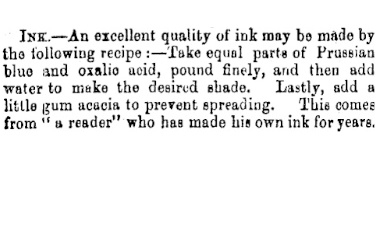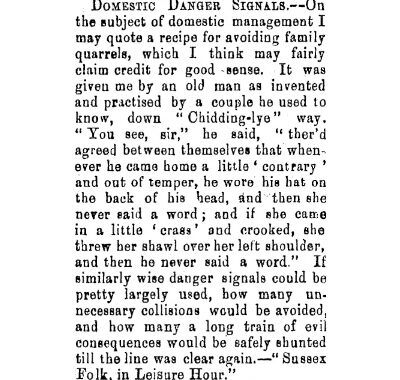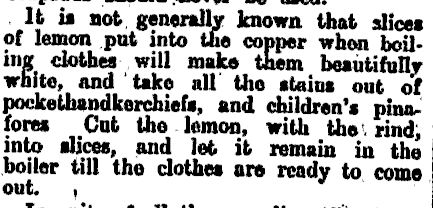To Avoid Domestics (Recipe from 1881) >>> Colonist, Volume XXV, Issue 2998, 1 November 1881,…
Home Made Ink (Recipe from 1874)

Home Made Ink >>>
Colonist, Volume XVI, Issue 1700, 2 January 1874, Page 3
Here is the ink recipe converted to metric measurements:
Original Recipe:
-
Equal parts of Prussian blue and oxalic acid, pounded finely.
-
Add water to desired shade.
-
Add a little gum acacia to prevent spreading.
Metric Conversion (example for a small batch):
-
10 grams Prussian blue
-
10 grams oxalic acid
-
100-200 ml water (adjust based on shade intensity)
-
1-2 grams gum acacia (dissolved in water)
modernized version of the ink recipe:
Ingredients:
-
10 g Prussian blue pigment
-
10 g oxalic acid
-
150 ml distilled water (adjust for desired ink intensity)
-
2 g gum arabic (modern equivalent of gum acacia)
-
Optional: A few drops of essential oil (like clove oil) to prevent mold.
Instructions:
-
Finely grind the Prussian blue and oxalic acid together using a mortar and pestle.
-
Slowly mix the powder into distilled water, stirring until fully dissolved and smooth.
-
In a separate small amount of warm water, dissolve the gum arabic, then combine with the pigment solution.
-
Add a few drops of clove oil to preserve the ink.
-
Store the ink in a sterilized, airtight glass bottle.
This recipe makes a stable ink suitable for dip pens or brushes
Fountain Pen-Safe Ink Recipe
Ingredients:
-
5 g Prussian blue pigment (finely ground)
-
5 g oxalic acid
-
100 ml distilled water
-
2 g liquid gum arabic (or 1 g powdered, fully dissolved)
-
1-2 drops clove oil (natural preservative)
-
1-2 drops glycerin (optional, for smoother flow)
Instructions:
-
Grind Prussian blue and oxalic acid very finely.
-
Warm the distilled water slightly (not boiling).
-
Gradually stir in the pigment and acid, ensuring full dissolution without grit.
-
Dissolve gum arabic fully in a bit of warm water, then add to the main mixture. This controls viscosity.
-
Add clove oil to prevent mold and glycerin for improved ink flow.
-
Strain through a fine mesh or coffee filter to remove any undissolved particles that could clog the pen.
-
Store in a sterile, airtight bottle.
Notes:
-
Always test on a dip pen before using in a fountain pen to ensure smoothness and prevent sediment.
-
Shake before each use, even after straining.
-
For extra safety, use a micro-mesh or ultrafine filter to ensure no particles remain.



